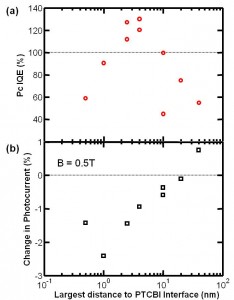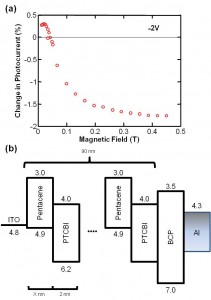Understanding Modulation of Photocurrent with Applied Magnetic Field in Singlet Fission, Pentacene, Photodetectors
- Category: Energy, Nanotechnology
- Tags: marc baldo, nicholas thompson, pentacene
Organic solar cells and photodetectors that feature singlet exciton fission materials have two additional exciton processes that traditional organic solar cells do not: singlet fission and triplet doublet annihilation. To maximize the usable power of the photovoltaic cell, we must understand how to optimize the gain from singlet fission and minimize the loss from doublet annihilation. We focus on the former here.
An organic photodetector is composed of thin layers of pentacene and PTCBI stacked repeatedly, as in Figure 1. This device structure is designed to enhance exciton dissociation at the donor/acceptor interface. The rapid dissociation of the singlet exciton in the photodetector competes with the singlet fission process, which is the formation of two triplet excitons from one singlet, and has been shown to be very fast and efficient [1] [2] . Modulation of the singlet fission rate by application of an external magnetic field changes the photocurrent by reducing the singlet fission rate relative to the rate of singlet dissociation into a charge. The high field asymptotic value of the change in photocurrent is proportional to the fission yield [2] .
We built photodetectors that utilize variably thick layers of pentacene to modulate the rate competing with singlet fission. The maximum the internal quantum efficiency (IQE) of 130% occurs for an 8-nm-thick pentacene layer. The trend in IQE is matched by the trend of an increasing change in photocurrent with applied magnetic field, as Figure 2 shows. We conclude that there is less competition between the singlet for performing fission and dissociating at the donor/acceptor interface.
The gain in IQE from the singlet fission process is largest for pentacene layers of 8 nm. The change in photocurrent suggests that the fission efficiency is even larger for thicker layers; however, we observe loss in IQE, which could be due to exciton diffusion.
- Figure 2: Pentacene IQE (a) and the change in photocurrent (b) for an applied magnetic field of 0.5T versus the largest distance to the PTCBI interface for pentacene photodetector and photovoltaic cells.
- Figure 1: (a) Plot of change in photocurrent versus magnetic field that exhibits the distinct singlet fission shape. The change in photocurrent is first positive, cross zero, and then asymptotes to a large negative value. (b) Device structure used to measure (a).
- M. W. B. Wilson, A. Rao, J. Clark, R. S. S. Kumar, D. Brida, G. Cerullo, and R. H. Friend, “Ultrafast dynamics of exciton fission in polycrystalline pentacene,” Journal of the American Chemical Society, vol. 133, no. 31, pp. 11830–11833, 2011 [↩]
- J. Lee, P. Jadhav, and M. A. Baldo, “High efficiency organic multilayer photodetectors based on singlet exciton fission,” Applied Physics Letters, vol. 95, p. 033301, 2009. [↩] [↩]

